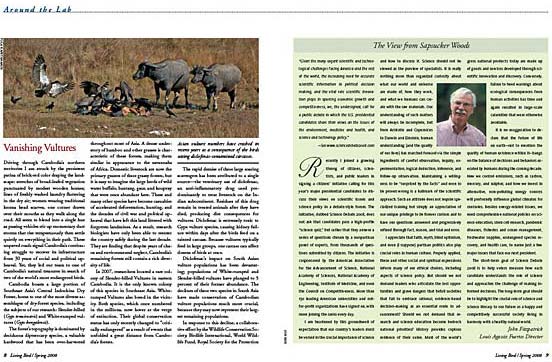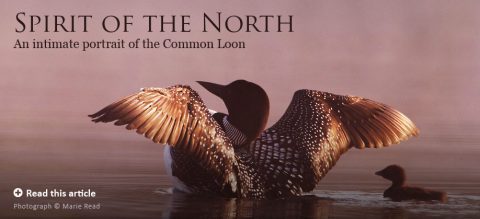Asia’s Crisis of Vanishing Vultures
By Yula Kapetanakos April 15, 2008
Driving through Cambodia’s northern territories I am struck by the persistent patina of brick-red color draping the landscape: stretches of broad-leafed vegetation punctuated by modest wooden homes; lines of freshly washed laundry fluttering in the dry air; women wearing traditional kroma head scarves, one corner drawn over their mouths as they walk along the road. All seem to blend into a single hue as passing vehicles stir up momentary dust storms that rise tempestuously then settle quietly on everything in their path. These unpaved roads signal Cambodia’s continuing struggle to recover its infrastructure from 30 years of social and political upheaval. Yet, they led our team to one of Cambodia’s natural treasures in search of two of the world’s most endangered birds.
Cambodia boasts a large portion of Southeast Asia’s Central Indochina Dry Forest, home to one of the most diverse assemblages of dry-forest species, including the subjects of our research: Slender-billed (Gyps tenuirostris) and White-rumped vultures (Gyps bengalensis).
The forest’s topography is dominated by deciduous dipterocarp species, a valuable hardwood that has been over-harvested throughout most of Asia. A dense understory of bamboo and other grasses is characteristic of these forests, making them similar in appearance to the savannahs of Africa. Domestic livestock are now the primary grazers of these grassy forests, but it is easy to imagine the large herds of wild water buffalo, bantang, gaur, and koupray that were once abundant here. These and many other species have become casualties of accelerated deforestation, hunting, and the decades of civil war and political upheaval that have left this land littered with forgotten landmines. As a result, research biologists have only been able to reenter the country safely during the last decade. They are finding that despite years of chaos and environmental neglect, Cambodia’s remaining forests still contain a rich diversity of life.
In 2007, researchers located a rare colony of Slender-billed Vultures in eastern Cambodia. It is the only known colony of this species in Southeast Asia. White-rumped Vultures also breed in the vicinity. Both species, which once numbered in the millions, now hover at the verge of extinction. Their global conservation status has only recently changed to “critically endangered” as a result of events that unfolded a great distance from Cambodia’s forests.
The rapid demise of these large soaring scavengers has been attributed to a single source—the veterinary use of diclofenac, an anti-inflammatory drug used predominantly to treat livestock on the Indian subcontinent. Residues of this drug remain in treated animals after they have died, producing dire consequences for vultures. Diclofenac is extremely toxic to Gyps vulture species, causing kidney failure within days after the birds feed on a tainted carcass. Because vultures typically feed in large groups, one carcass can affect dozens of birds at once.
Diclofenac’s impact on South Asian vulture populations has been devastating; populations of White-rumped and Slender-billed vultures have plunged to 5 percent of their former abundance. The declines of these two species in South Asia have made conservation of Cambodian vulture populations much more crucial, because they may now represent their largest remaining populations.
In response to this decline, a collaborative effort by the Wildlife Conservation Society, Birdlife International, World Wildlife Fund, Royal Society for the Protection of Birds, and Cambodia’s Department of Nature Conservation and Protection and Forestry Administration is in progress to monitor vulture populations in protected areas in northern and eastern Cambodia. The Lab of Ornithology’s Fuller Evolutionary Biology program joined these efforts this year and is now using the latest genetic techniques to investigate questions on avian biology—in this case, vulture demographics.
Most conservation efforts begin by asking one fundamental question: How many individuals exist within a population? At this time, we don’t know how many vultures live in Cambodia. Researchers continue to count birds at designated feeding stations, but gathering accurate bird census data from afar can be a difficult feat. The Lab of Ornithology is helping in this effort by analyzing vulture feathers gathered at these feeding stations. Through their bickering and jostling for prime feeding spots, vultures often lose feathers, from which we can extract DNA that describes an individual’s unique genetic make-up. Analyzing large numbers of these feathers is a noninvasive process that more accurately estimates population size.
But many questions remain. We are still in the early stages of understanding the vultures’ migration patterns, which often extend over thousands of miles. We need more data. One way to obtain it is by attaching satellite transmitters to the birds. These tiny devices have been used successfully to track vultures, and they are now better than ever. Improvements in solar power have extended the transmitters’ longevity, and GPS technology has made them more accurate. Tracking these birds can alert us if they migrate to hazardous destinations.
An unfortunate conundrum exists in endangered species research. The urgency of our need to understand and protect critically endangered animals sometimes runs counter to the needs of good science: time and resources. It’s a frustrating reality of our work but a challenge well worth undertaking, considering the alternative. If we fail, the brick-red roads of Cambodia will no longer lead us to a habitat where the broad-winged silhouettes of vultures shadow the skies.

All About Birds
is a free resource
Available for everyone,
funded by donors like you
American Kestrel by Blair Dudeck / Macaulay Library



